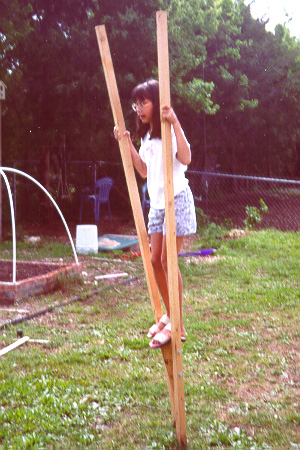Stilt Walking
As you therefore have riecieved Christ Jesus the Lord, so walk in Him
Colossians 2:6 |
One evening in early April, 2000, Dad and I decided to make stilts.
We had been thinking about it, but I had not counted on them being made until summer.
Dad had the materials, some scraps of wood. We made them with ajustible hieght. Though it took us less than an hour to make, they are still a lot of fun weeks later.
Background
Did you ever see a stiltwalker at the circus, in a parade or read about one in a book? It looks so easy. I always wondered if it was one of those activities like juggling that takes hours of practice before you make any progress at all. Some stiltwalkers seem so high up they could hurt themselves if they fell. They must be pretty brave. I thought that if I got the chance, I would start out closer to the ground and work my way up!

Materials
This is what we used to make our stilts:
- Wooden posts
- One 8 foot long 2 by 4 cut in half (two 2 by 2's will work too)
- Two trianglular wooden steps
- Each is a right triangle with 11 inch base and 5 inch rise cut from the end of a 2 x 6 (we asked for ours at a construction site)
- Four 4 inch carriage bolts with 8 washers and 4 wing nuts
- Go to a hardware store and ask for these.
- One electric drill with a long 1/4 inch and 1/2 inch bit
- If you don't have one in your garage, a neighbor probably does
- A square
- A drafting square, carpenter's square or the corner of a hard back book will do.
- A ruler and two pencils
- Raid your school box.
- Good shoes
- You need shoes that will grip the steps and not slip (the picture was taken after I could stiltwalk pretty well)
- A yard with hard ground
- It may help to have soft grass on it at first
Construction
Putting it together didn't take long. It's really just a matter of drilling holes and putting the screws in. But if you don't have a drill press (and we don't) it can be a bit tricky. Look at the picture or some of these instructions may not make sense. Above all, be careful, wear goggles, gloves and have your parent help or do it for you.
Step-by-step instructions:
- Get all the materials together.
- Measure along the base of a step and mark a spot 3 inches from the point. Use a square lined up with the base and draw a line on the side to see where the hole you will make should come out. Mark a dot in the center of the side it comes out on. You should have two dots and a line marked.
- Set the step on a scrap piece of wood with its base down. Drill the 1/4 inch hole you marked starting from the sloping side so you are drilling straight down along the line you drew. If it doesn't come out on the base where you marked the first dot, try drilling from the dot on the base back to the one on the other side. This is tricky because you have to drill at an angle lined up with the line you drew but keeping it in the middle.
- Drill another 1/4 inch hole the same way, 6 inches further up the base of the step. The step should have two holes in it that will anchore it to the posts.
- On the sloping side of each step, widen the the holes to 1/2 inch with the drill to within two inches of the base of the step for a 4 inch bolt. The idea is to sink the head of the carriage bolt into the step so it can stick out half an inch on the other side of the post.
- Drill holes in the other step the same way.
- Mark a dot on one post 4 inches from one end. As before, mark a line with the square and a dot in the middle of the other side where the drill bit should come out.
- Put a pencil in each hole of one step with the lead tip poking through the base. It could be a tight fit so you may want to sand or shave the pencil before hand to take the ridges off.
- Put one pencil tip on the mark you made on the post. Mark another dot up the post with the other pencil tip. Make a few more marks this way for as many height adjustments as you want. Use the square to mark a line and another dot for each mark as before to help guide drilling straight through.
- Drill the holes you marked in the post. It should be easier to get them straight.
- Process the other post using the other step the same way.
- Put a washer on each bolt and insert them in the holes of sloping side of each step. Pull the threads through on the base side.
- Insert each step into a post using the lowest pair of holes. The point of the step should be toward the end of the post where you marked the first hole.
- Put a washer and wingnut on the end of each bolt and tighten.
- Check the wingnuts each day before using the stilts so they don't come loose on you.

Walking on Stilts
Start with the steps on the lowest setting. We had someone hold the posts as we got on the steps and held on to the posts. Gloves help to keep your grip. At first, two steps was the most we could do. We learned that you have to lift your foot and the post at the same time. As you lift the post with your hand, swing the step out a bit with your foot.
| At first, it helps to keep your toes on the steps rather than the middle of your foot. |
In a day or two, we could get on the stilts ourselves. Holding them apart with one behind the other helped to slow our momentum as we stepped up on the front stilt. With the stilts at the lower setting, falling was never a problem. We worried about slipping off the steps more. Nevertheless, we stayed away from windows and eachother as the posts came crashing down sometimes.
By the next week, we could walk all over! We could also use higher settings for more of a challenge. As the saying goes, "Practice makes perfect."
Staying on High Ground
Stilts are fun just to see if you can walk on them. But I have to think they might come in handy someday if there was a lot of snow on the ground or a flood. They would make it possible to stay dry while crossing our yard or street since we don't have sleds or boats.
Our faith is like stilts in some ways. It keeps us from getting soiled by the world so we can do God's work. But it takes patient practice and exercise to keep from the temptations of the world. Temptations try to trip us up, get us mired down in bad habbits and make our walk of faith difficult.
| God will reward those who walk by faith in Him and we will be with Him forever! |
Copyright © 2000 Erica Lastufka, All rights reserved worldwide.

